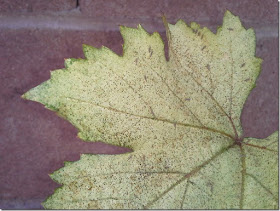 |
| Characteristic leafhopper damage on grape leaves.Notice the white spots on the leaf surface from feeding by this very small jumping insect. |
A. Leafhoppers can be a
huge problem on grapes grown in the Mojave Desert. They are often confused with
other insects but if walking past your grapes and hundreds of tiny insects jump
into your face, then they are probably leafhoppers.
Once reaching large populations, adult leafhoppers are
extremely difficult to control without hard pesticides. Hard pesticides are not
“organic”. If you don’t start spraying early, these insects will be a huge
problem later in the season and much more difficult to control.
The key to effectively using “softer pesticides”, closer
to organic types of control, is to look for the juveniles on the bottom of
leaves early in the season. Use soft pesticides in rotation with each other and
spray when the younger populations are on the rise.
Softer pesticides are not necessarily “organic” but are
safer for humans and the environment. These pesticides, used in rotation,
include insecticidal soaps like Safer, neem oil, spinosad, pyrethrin and even
horticultural oils when temperatures are cooler.
Rotating these pesticides means to use a different
pesticide in your arsenal each time you spray. Begin looking on the bottom of
leaves when grape berries are the size of large peas. Once leafhoppers are seen,
spotcheck leaves every week. Remove leaves that surround the grape bunches very
early. Very important for insect and disease control.
Juvenile leafhoppers don’t look much like the adults. But
adults will populate the undersides of the leaves with these “babies” quickly
once they start. Inspect the bottoms of leaves weekly and spray if populations are
increasing.
 |
| Extreme leafhopper damage to grapes when you stand back a bit and look at the vines. |
Use a different “soft pesticide” each time you spray. You
may need to spray every week but this decision should be made after looking at
juvenile populations. Remember, young ones are easier to kill than the adults.
Non-organic, commercially grown grapes use hard
pesticides. Hard pesticides knock problem pests back longer but are not as
friendly with the environment, human consumption and other insects in the area nearby.
“Softer” pesticides must
be repeated more often. Use them in rotation. Check populations and look for
the juveniles. Start spraying early when the juvenile population is building.


Oh, I love you for this post! I've been having the same exact problem and couldn't find any info when I googled it. This is one of my all time favorite websites! I'm always checking it for my Las Vegas gardening solutions. Thank you so much for making this available!
ReplyDelete